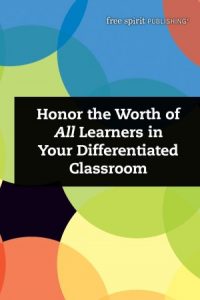
Honor the Worth of All Learners in Your Differentiated Classroom
Diane Heacox, Ed.D.
In what ways might a classroom reflect equity and access and also respond to the specific needs of students representing the broad diversity of our schools? Can teachers differentiate and use flexible instructional grouping without issues being raised about equality?
All students, indeed, need access to challenge, engagement, novelty, and exploration as well as opportunities to follow their interests, curiosities, and passions through intriguing learning tasks. However, in recognizing the diversity among our students, we must also affirm that not all students need to learn, think, and do in the same (equal) ways. Equity and access are reflected in a teacher’s recognition that unique learners need personalized approaches to learning.
There is much a teacher in a differentiated classroom can do to ensure all students are and feel part of a community of learners. First, let’s consider the qualities of a classroom environment that both supports differentiation and affirms the value of each student. A supportive classroom:
- promotes acceptance of differences
- affirms that all students have learning strengths
- acknowledges that students learn at different rates and in different ways
- recognizes that for work to be fair, it must sometimes be different
- acknowledges that success means different things to different people
- allows students to work with various people for various purposes
- recognizes that the key to motivation is interest and that all students have different interests
- promotes personal responsibility for learning
- builds feelings of personal competence and confidence in learning
- values effort and “personal best”
- nurtures skills of independence
- supports and celebrates student success in challenging work
- encourages the exploration of each student’s interests, strengths, and learning preferences
- nurtures the creative spirit in all students
- honors everyone’s work
A supportive environment is vital to the success of a differentiated classroom.
In addition to an environment that recognizes and supports all learners, the thoughtful design and facilitation of instructional tasks is critical to the students’ sense of fairness. In a differentiated classroom, it is accepted that not all students will be engaged in the same learning at the same time, doing the same tasks. As such, the design and facilitation of differentiated tasks must be viewed as fair by students. What critical features define respectful tasks for all learners? Consider the following as you design and facilitate differentiated tasks in your classroom:
- Do all tasks focus on significant learning based on standards?
- Are students matched to tasks based on their readiness, interests, or learning preferences to ensure success?
- If choices are being offered, do all students have choices in content, ways to work, or ways to show what they have learned?
- Are all tasks designed to be equally engaging and interesting (fun!)?
- Do tasks reflect different work, not just more work?
- As appropriate, are scaffolding and support for success available to students?
- Does it appear that all tasks have been designed to require similar amounts of time for completion?
- Are all students likely to be successful in their tasks with appropriate effort?
- Are all students able to share the results of their work with a partner, a small group, or the class as a whole?
- Are the partnering and grouping arrangements flexible and ever changing so that students are able to be grouped by readiness, interest, or learning preference?
- Is student work evaluated in similar ways with similar quality criteria?
- Is the work of all learners respected and honored?
Differentiated classrooms reflect both access and equity for all students. Through creating supportive learning environments and fair and equitable learning experiences, we convey the value and worth of all learners.
This article was originally posted at Free Spirit Publishing.